With so many places to visit, we always keep a small list of questions in mind that help guide our travels. Is there unique geography, wildlife or landscapes we might not find anywhere else? Is there an ancient history we can explore and experience? Is there a culture of food and drink in which we can indulge? Are there unusual cultural attractions we can visit? Is there a one-of-a-kind outdoor experience, activity, tour, or location we just can’t miss? How touristy is it and can we actually tolerate a visit?
Most places we visit hit two or three of the criteria. The small city of Évora, just a train ride east of Lisbon, surprised us with everything and then some. In all of our previous and current travels in Portugal, we just couldn’t believe we overlooked Évora. We’re also somewhat regretful that we didn’t give it more time during this visit. We spent the nights of December 5 and 6 in Évora in between visits to Lisbon and Seville and really wish we had stayed there longer. Looking on the bright side, there’s definitely reason to come back and a lot to share here from our two short days.
The Ancient
Archeological evidence from the Évora region has demonstrated that there has been a constant human presence in the form of domesticated settlements for at least 8,000 years or since the sixth millennium B.C.–a very, very long time. In fact, the stone monuments that make up the Almendres Cromlech represent some of the earliest evidence of human settlement in all of Europe, predating both Carnac and Stonehenge.
What’s a cromlech you might ask? Basically a bunch of really big stones placed in a somewhat circular arrangement that likely served as the memorial and celebratory center of the community. Honestly, nobody knows why ancient people felt the need to stand rocks on their ends, but they did it very deliberately and scientifically. The Almendres Cromlech is aligned perfectly East pointing downhill from the highest point in the region. This is remarkable because it demonstrates that the ancient residents had the leisure time and inclination to watch and record celestial events over a period of generations. It is really amazing when you start getting into what we think we know about these big rocks. Our guide Sira from Ebora Megalithica is an expert on the subject and helped bring the site to life for us.
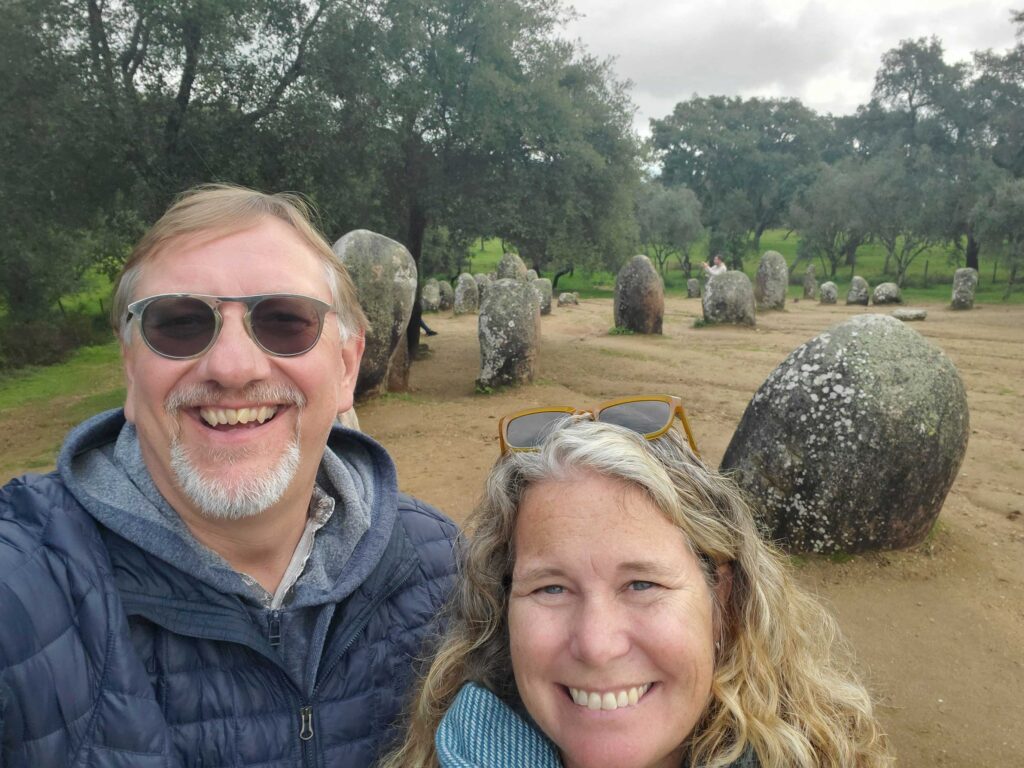

One of the current theories about why they did this, based on ancient folklore, speculates that each stone is a representation of an elder or ancestor. Careful inspection has revealed what appear to be faces and shepherd’s crooks, demonstrating the likelihood they represent powerful people in the community.

We could geek out on the rocks forever, so if you’re interested, do check it out. And wait, there’s more! Where there’s a cromlech, why not throw in a dolmen!

What’s a dolmen? Well, these structures were clearly burial sites for communities. From this picture, imagine a giant hill that encompasses an area higher than the metal roof with a stone door in front leading to a long stone passageway that eventually reaches a giant stone chamber. That’s what the Great Dolmen of Zambujeiro was before “archeologists” from the 1960s completely destroyed it and left behind what you see today.

This dolmen is younger than the site we visited previously. Only about 6,000 years old. It’s structure stood the test of time until somebody dug out all the dirt supporting it and it started to collapse.
So, that’s the oldest of the ancient, but that isn’t all Évora has to offer in the ancient column. There are also Roman ruins scattered around town, like this temple in one of the city squares.
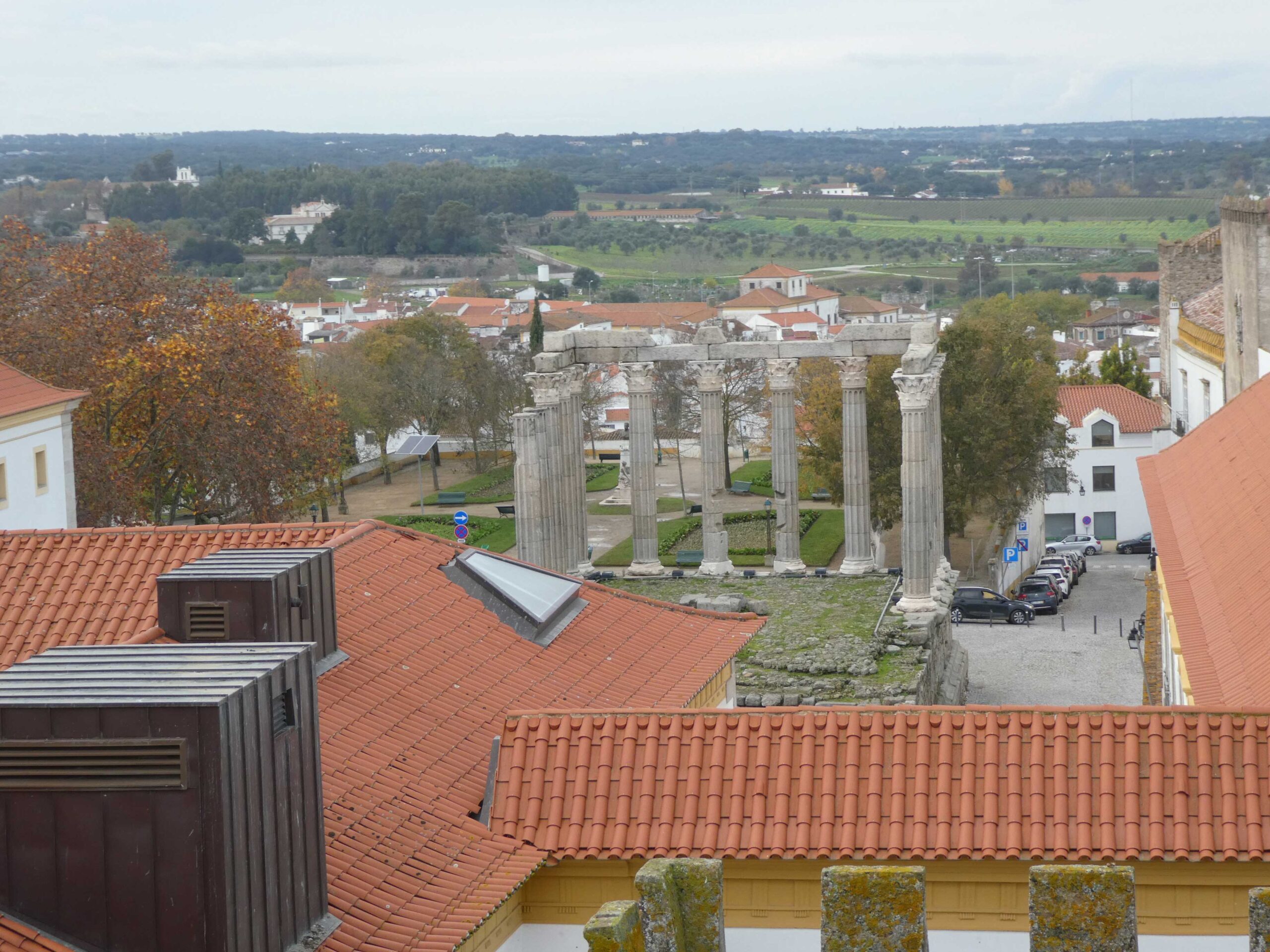
There’s also baths and such from Roman times, but we won’t bore you with too much more. However, you also have to give the Portuguese their due. An aqueduct built by Portuguese engineers dating from the 15th to 16th centuries runs across the landscape and through the town.

The aqueduct actually worked on a pressure system and not solely gravity. It runs into and through town. Today, where are even some houses built around and on the remaining structures. In all, a really impressive collection of ancient things to see dating back to some of the earliest on the European continent.
The Landscape
The landscape around Évora and the surrounding villages is filled with pasture and forest. Nothing terribly unique there, you might think. However, if you consider what we’ve gone through in the Western United States with constant brush and forest fires due to climate change, Évora is very unique. Their forest are actually fireproof. What? you say. How is that possible?
A couple of reasons… 1) There is a huge aquifer under the entire region so even though it is a hot, arid part of the country, the vegetation remains green due to ample underground sources. 2)The region is actually one of the largest producers of cork in the world, and the cork oak tree is naturally fireproof. Generations of landowners have manicured the forests to place the trees at equal distances to allow for efficient cork regeneration and harvesting.
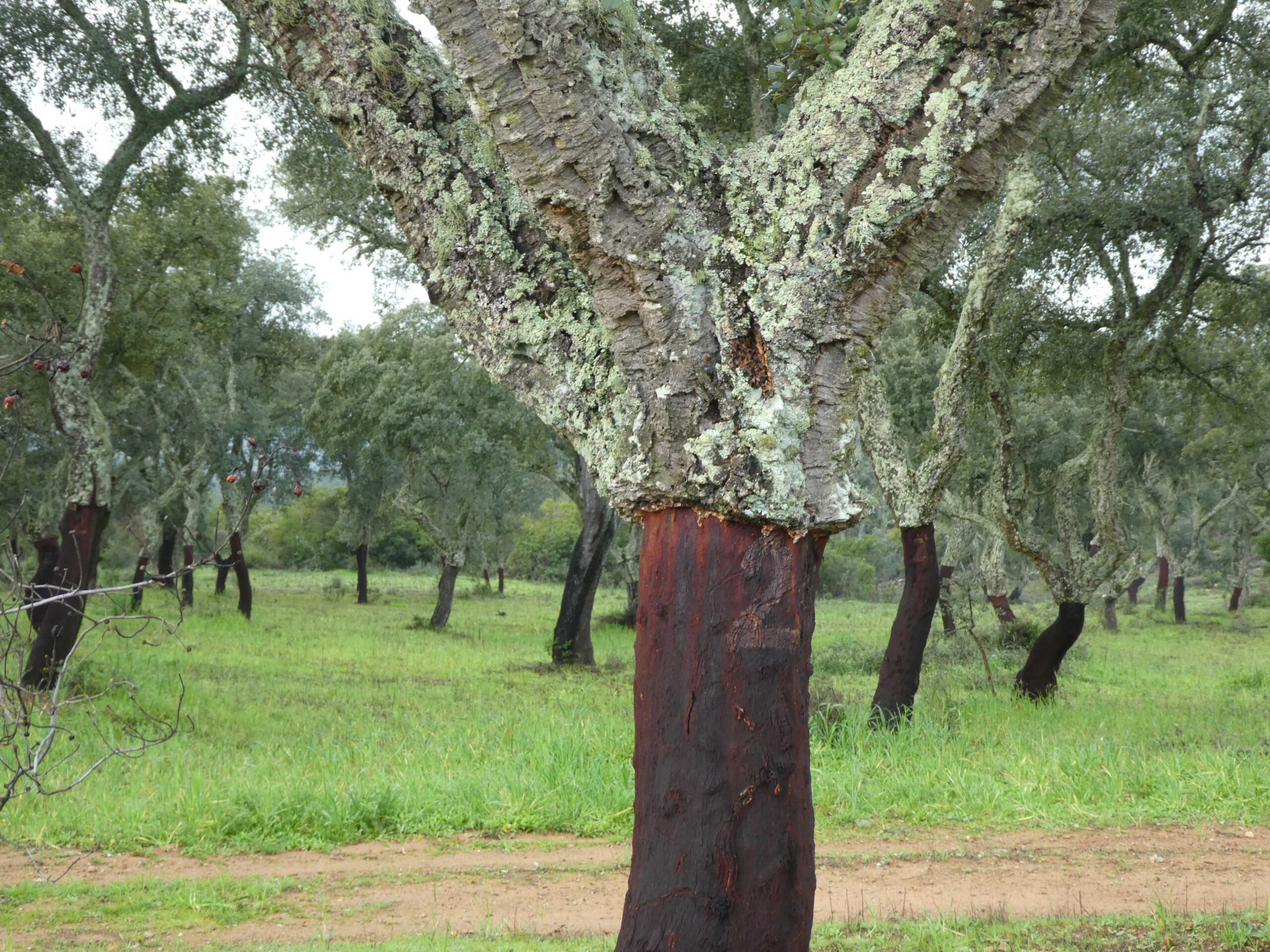
This forest was harvested in 2022, which is indicated by the #2 on the tree. A cork oak tree has to grow for at least 30 years before the bark is harvested for the first time. Then new bark can be harvested every 10 years. Growers rotate fields to maintain constant production. There’s a stark contrast between the older, lichen-covered canopy and the newly stripped trunk.

While the forest is fireproof and appears to be abundantly green, the cork oaks of Portugal are not immune to the effects of climate change. The line down the middle of this tree is where a preliminary incision was made in 2021 to harvest the bark, but due to drought, the tree was not ready for harvest after the usual 10-year cycle. They also have another cool native oak that you can actually eat the acorns straight from the tree, but we won’t let Ande geek out on the trees too much and leave it at that.
The Culture
Ultimately, Évora is worth visiting just for its charm. The cobbled streets are lined with local businesses, with enticing restaurants hidden down narrow alleyways. In addition to the food, the region is also a big cheese and wine producer. The town’s restaurants are proud to feature local products. Each place we visited made sure we knew where every element of our dinner came from.


This view of the town captures the street cafe culture prevalent in Portugal during any weather and showcases a variety of architecture where the arches and balconies reveal the slope of the road upon which they are built.

The theme of whitewashed buildings with yellow, red, and other colorful accents is carried across the town. Rather than mandated by covenants to maintain uniformity or compliance, the whitewash is simply the most practical way to control building temperatures in the summer.

The Unique
Okay, so now is where things get a little weird. Seems like a perfectly serene and normal little town as viewed from the balcony of the Church of San Francisco, where the picture above was taken. However, this church contains one of the most unique and somewhat gruesome sights we’ve ever encountered–the Chapel of the Bones. Most Catholic attractions have some sort of gruesome collection of parts of saints, martyrs, bishops and priests housed in crypts and reliquaries (we will refrain from additional comments on the peculiarity of parts of people closed into vases for eternity), but the Chapel of the Bones is a kind of gruesome all its own. The bones of thousands of monks removed from 42 monastic cemeteries (somebody had better use for the real estate) were preserved in a single chapel in the form of decoration. Every inch of the chapel, bearing the inscription “Our bones that lie here are waiting for your bones,” is covered in the bones of monks. Nothing else to do but fall on the old cliche that a picture, or several, is worth more than a thousand words.
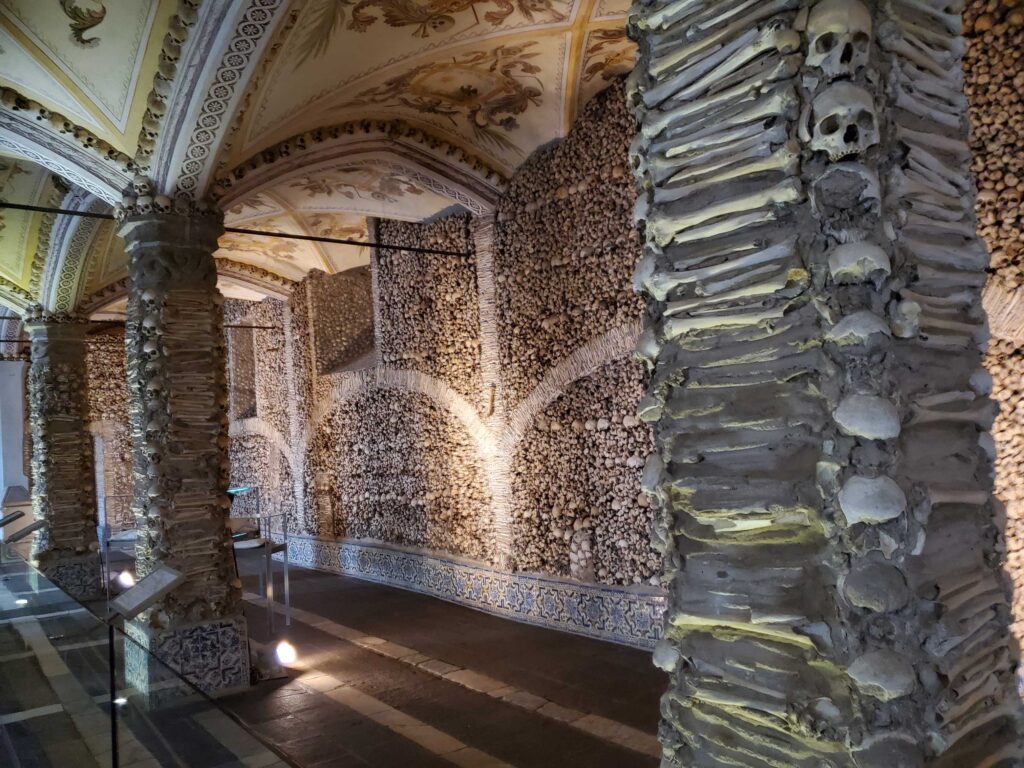

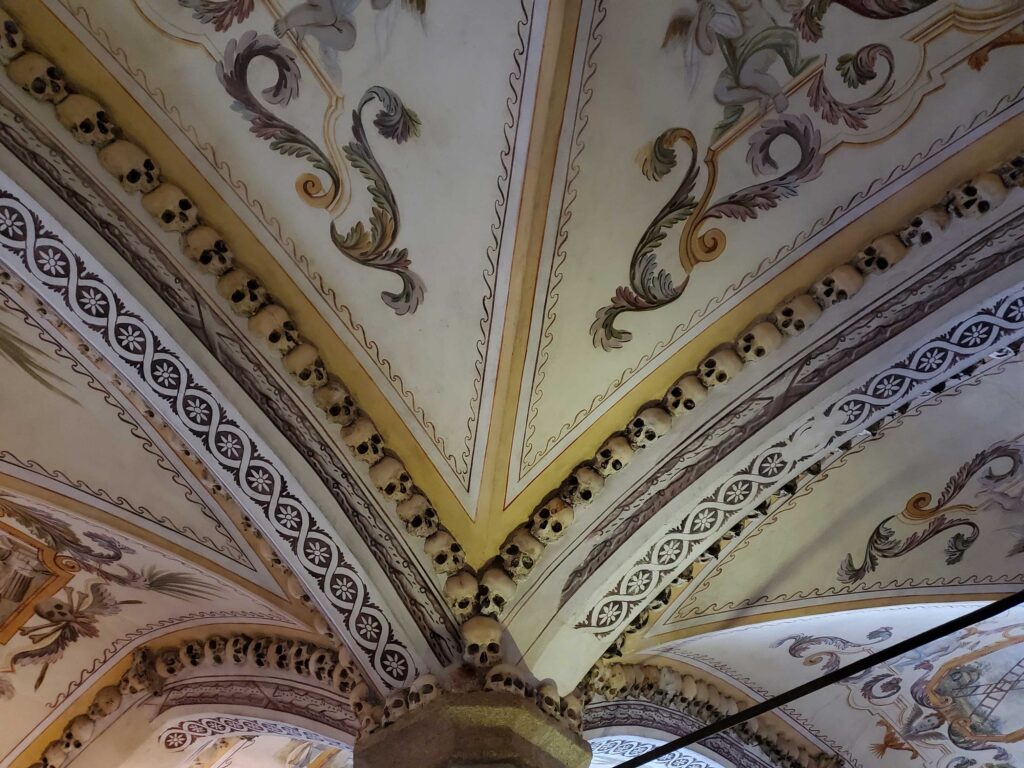

You may encounter crypts and catacombs filled with bones of the deceased in other parts of the world, but we’re guessing you’d be challenged to find anything similar to the decorative manner in which these monk’s bones have been preserved.
While the Chapel of the Bones is certainly enough uniqueness for one visit, the Church of San Francisco had another surprise in store for us. Being the holiday time and all, the church had acquired, for special exhibition, one of the largest personal collections of nativity scenes in the world. We’re talking more than 1,500 nativity scenes from all around the world. There was literally everything from the very big to the very small made from nearly every material imaginable including shell, bone, and even stone. Again, here are the pictures to tell their own story.

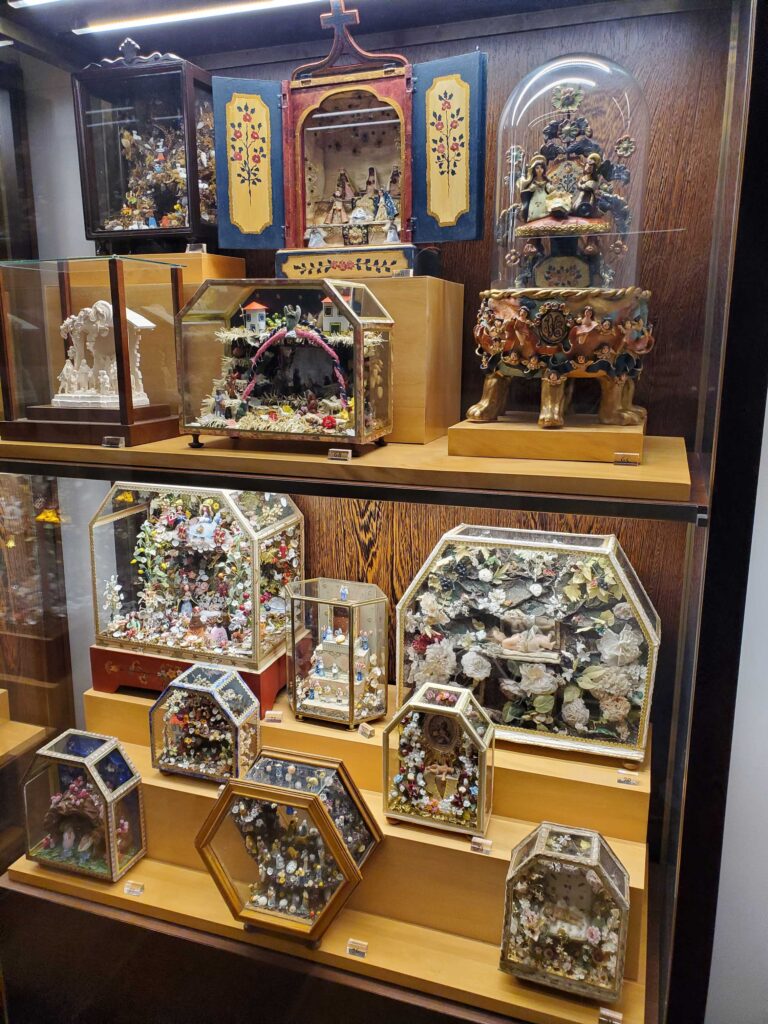
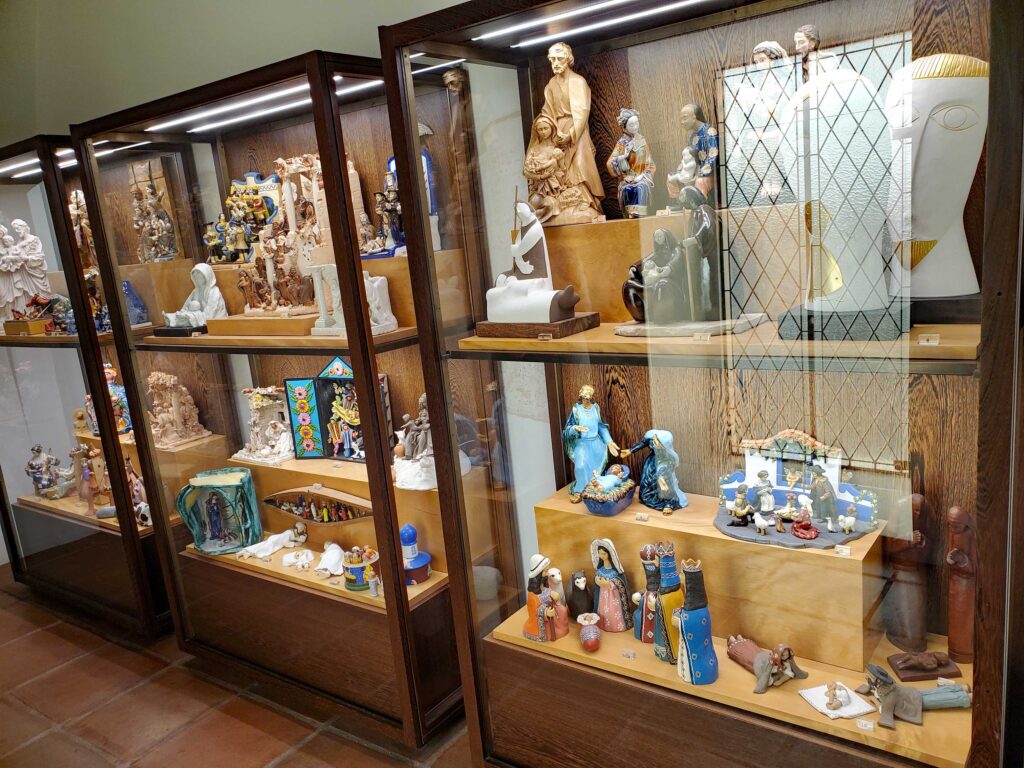
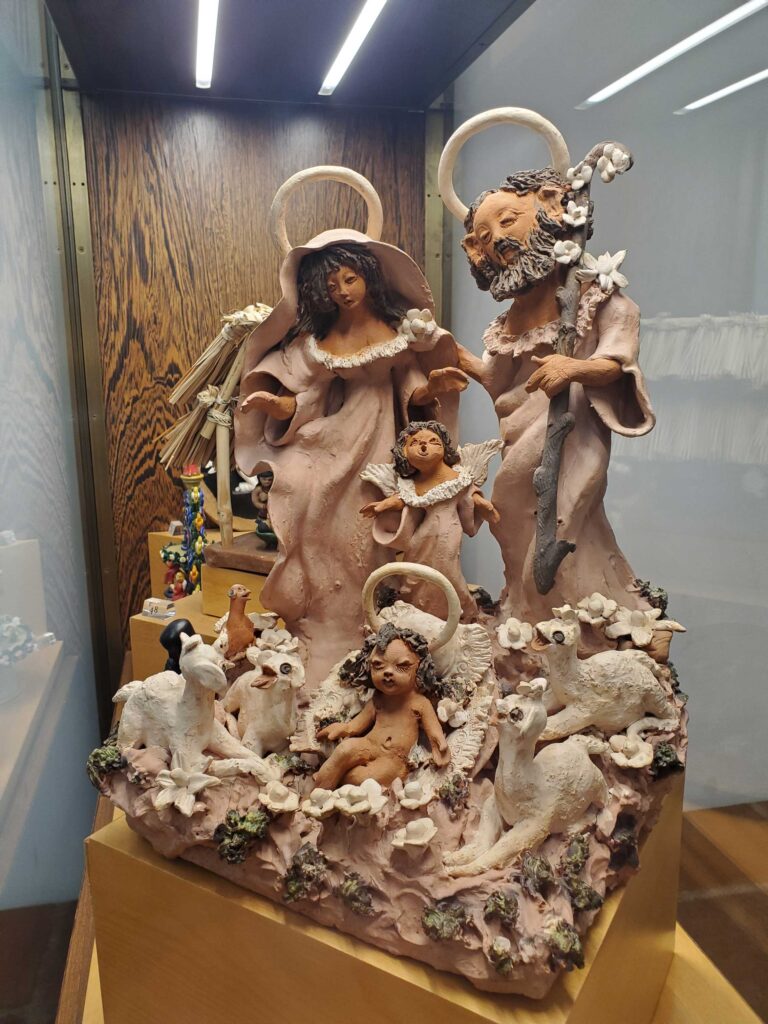
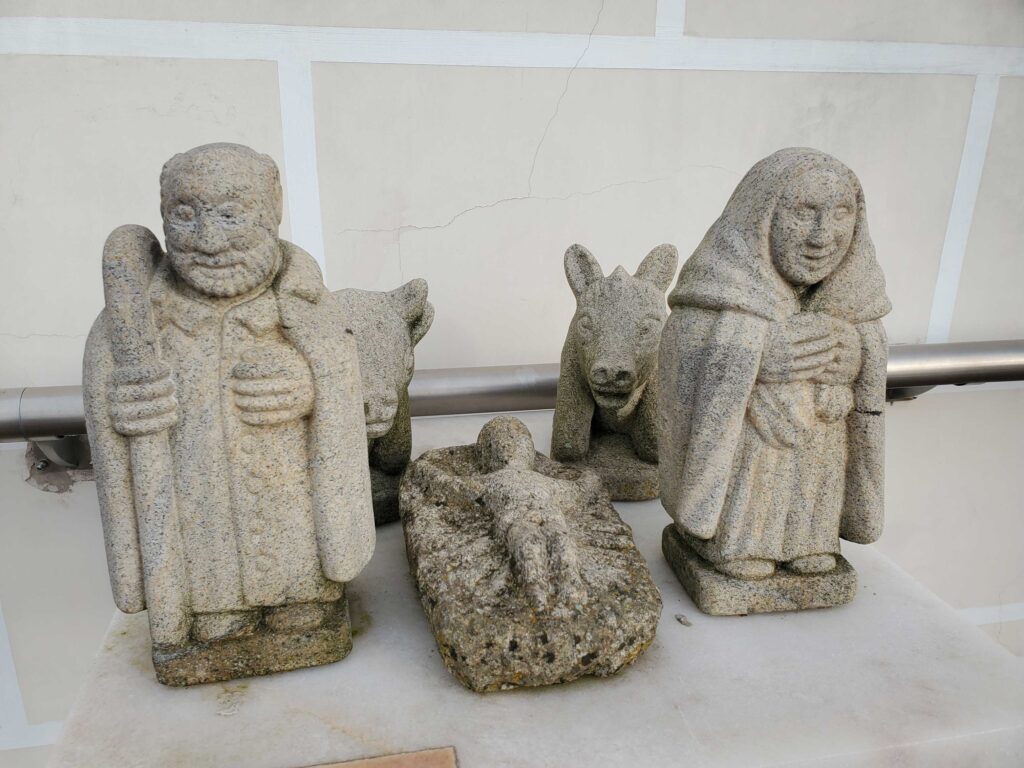
The Outdoors
Évora, Portugal certainly had plenty to keep us engaged, amazed, and wanting to come back for more. Turns out, we just aren’t done yet. There’s a large city park just across a parking lot from the Church of San Francisco that had a little cafe, gardens, and even more ruins. The single feature we found so amazing in this public outdoor space was the huge colony of peacocks. They were literally everywhere. I think there’s at least seven in this picture alone hiding in trees, shrubs, and on the roof of the gardener’s shed.

San Francisco also, of course, wasn’t the only church. The Se in Évora was a fun visit. It is part church and part medieval fortress. While not very decorative inside or out, we did get to go up on the roof and enjoy the view from outside the church.
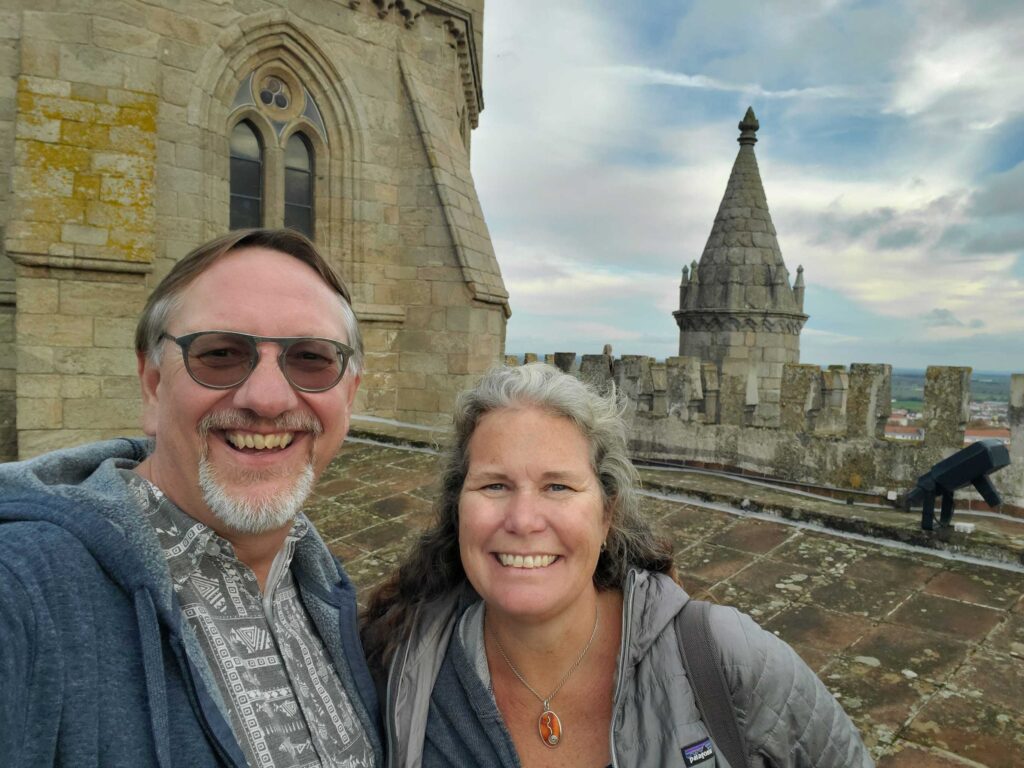
We actually covered quite a bit of ground in two days judging from what we’ve shared here, but we really barely scratched the surface. We didn’t get to visit many of the fine restaurants or enjoy the surrounding villages and wineries. Getting the chance to visit Évora again is just one more reason we’d love to live in Portugal someday if we could work it out. We’re fairly certain we’ll be back here again soon.
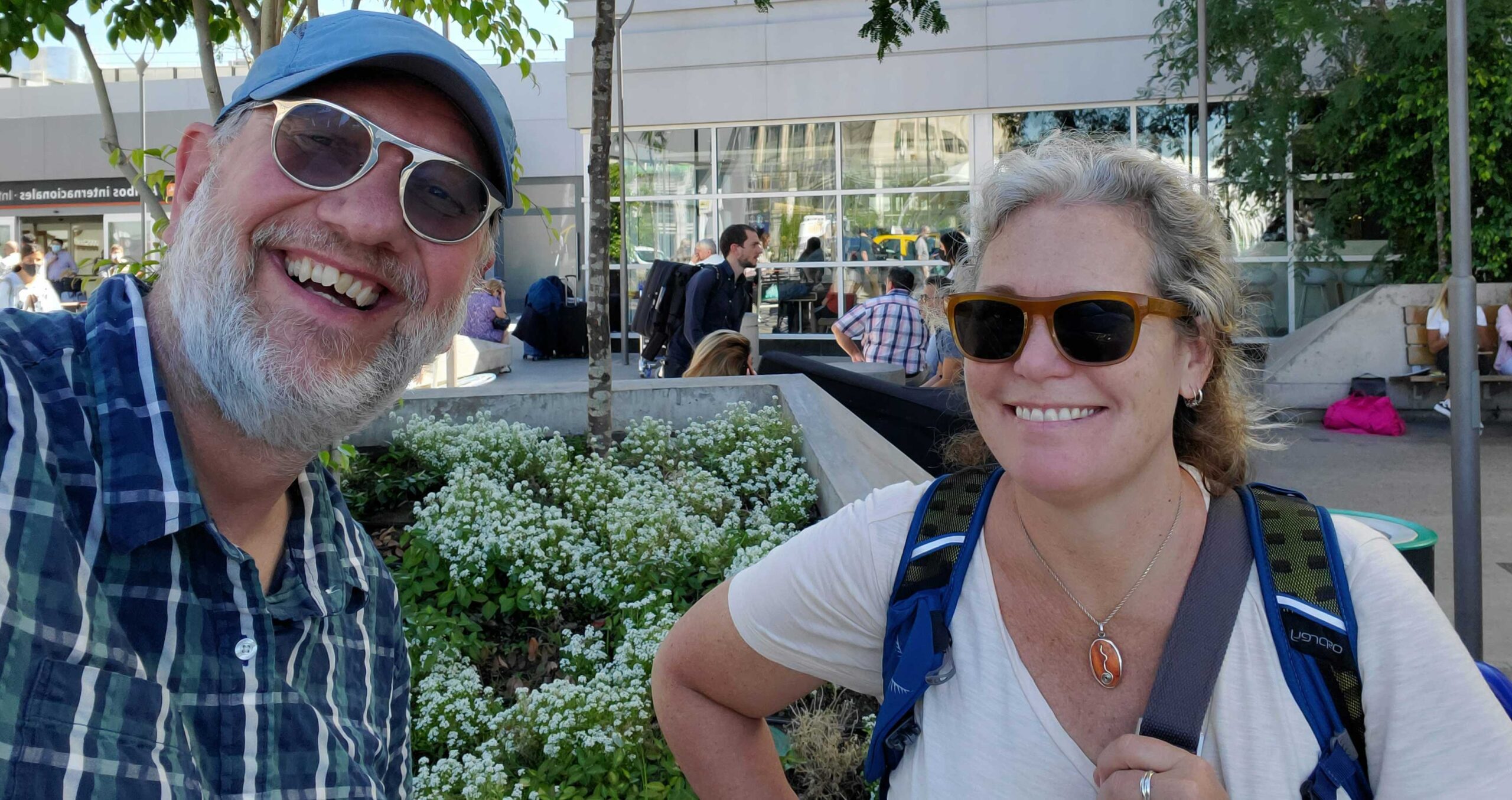
I thought there was a robot dog behind you in the last photo…
Ande said the same thing! We have no idea what it is.
Thanks for the interesting history lesson. Enjoying your photos.
Interesting, Portugal, I mean. the Chapel of bones was ? I see why you have enjoyed Portugal so much. In spite of weather. Mom C
We’re going to Belize next week for 10 days (Dec 20-30). Just sayin’ in case (but seems like you’re still in Europe)!
Sounds awesome! We love Belize. Actually have a ticket back to the states tomorrow for the holidays. Have a great trip!
“A stylish molding of monk skulls decorating the vaults of the ceiling”
Quite possibly the best photo caption you’ve written.
Yeah, I thought that deserved a little extra poetry. It is a crazy place.